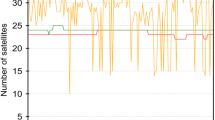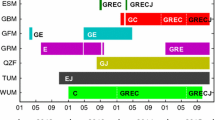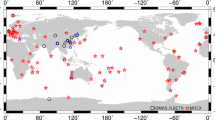Abstract
Multi-GNSS orbits from the analysis centres (ACs) of the multi-GNSS Pilot Project of the International GNSS Service (IGS) are combined at Wuhan University after aligning individual orbits to the IGS reference frame realized by the operational combined GPS orbits and assigning robust weights for each constellation. The consistency between combined orbit and individual AC solutions is assessed using the weighted root mean square of the orbit residuals over 2 years. In general, orbit comparison between the combined and AC solutions shows that the GPS orbits achieve the best consistency, followed by Galileo and GLONASS, BeiDou-2 and QZSS containing IGSO and GEO satellites, obtaining the largest scatter of orbit residuals. Moreover, the impacts of the change in processing strategies for individual ACs during precise orbit determination are also investigated in terms of constellation-specific transformation parameters. The obvious bias of scale and equatorial translation parameters derived from orbit comparison is identified, which may be related to the inclusion of more satellites and the updated phase centre offset (PCO). The updating of orbit models also shifts the orbit scale. The accuracy of the combined orbits is evaluated with satellite laser ranging (SLR) observations, and the root mean square of 2.3 cm, 3.6 cm, 5.0 cm and 2.9 cm is achieved for the Galileo, GLONASS, BeiDou-2 IGSO and BeiDou-2 MEO satellites during non-eclipse season, respectively, and it is at the decimetre level for the QZSS IGSO satellites. However, there are systematic sun elongation angle-dependent patterns in the SLR residuals for those satellites, which are mainly due to the noncubic shape of the satellites and partly generated by not modelling the thermal radiation pressure. Hence, refined orbit models are suggested to be adopted by ACs for multi-GNSS analysis.














Similar content being viewed by others
Data availability
The SLR observations used for this study can be freely downloaded from the Crustal Dynamics Data Information System servers, i.e. ftp://ftp.cddis.eosdis.nasa.gov/slr/data/npt_crd. The Multi-GNSS orbits of all MGEX ACs can also be freely downloaded from three data centres, i.e. Institut Géographique National (IGN) on ftp://igs.ign.fr/pub/igs/products/mgex, WHU on ftp://igs.gnsswhu.cn/pub/gps/products/mgex and CDDIS on ftp://ftp.cddis.eosdis.nasa.gov/gps/products/mgex. The combined Multi-GNSS orbit solutions can be download from WHU data centre at ftp://igs.gnsswhu.cn/pub/whu/MGEX.
References
Arnold D, Meindl M, Beutler G et al (2015) CODE’s new solar radiation pressure model for GNSS orbit determination. J Geod 89:775–791. https://doi.org/10.1007/s00190-015-0814-4
Bar-Sever Y (1996) A new model for GPS yaw attitude. J Geod 70:714–723. https://doi.org/10.1007/s001900050060
Beutler G, Brockmann E, Gurtner W et al (1994) Extended orbit modeling techniques at the CODE processing center of the international GPS service for geodynamics (IGS): theory and initial results. Manuscr Geod 19:367–386
Beutler G, Kouba J, Springer T (1995) Combining the orbits of the IGS analysis centers. Bull Géod 69:200–222. https://doi.org/10.1007/BF00806733
CAO (2019) QZSS Satellite Information. The Cabinet Office, Government of Japan. https://qzss.go.jp/en/technical/qzssinfo/index.html. Accessed 6 Apr 2023
Chen K, Xu T, Chen G, et al (2015) The orbit and clock combination of iGMAS analysis centers and the analysis of their precision. In: Sun J, Liu J, Fan S, Lu X (eds) China satellite navigation conference (CSNC) 2015 Proceedings, vol II. Springer, Berlin, pp 421–438
CSNO (2019) Satellite Information of BDS, China Satellite Navigation Office. http://en.beidou.gov.cn/SYSTEMS/Officialdocument/201912/P020200103556125703019.rar. Accessed 6 Apr 2023
Dach R, Schaer S, Arnold D, et al (2018) Center for orbit determination in Europe (CODE) Technical Report 2017. In: Villiger A, Dach R (eds) IGS Technical Report 2018. IGS Central Bureau. pp 31–46
Dach R, Schaer S, Arnold D, et al (2019) Center for orbit determination in Europe (CODE) Technical Report 2018. In: Villiger A, Dach R (eds) IGS Technical Report 2019. IGS Central Bureau
Deng Z, Fritsche M, Nischan T, Bradke M (2016a) Multi-GNSS ultra rapid orbit- clock- & EOP-product series. GFZ Data Serv. https://doi.org/10.5880/GFZ.1.1.2016.003
Deng Z, Fritsche M, Uhlemann M, et al (2016b) Reprocessing of GFZ multi-GNSS product GBM. IGS workshop 2016b, Sydney, Australia
Dilssner F, Springer T, Gienger G, Dow J (2011) The GLONASS-M satellite yaw-attitude model. Adv Space Res 47:160–171. https://doi.org/10.1016/j.asr.2010.09.007
Dilssner F, Springer T, Schönemann E, Enderle W (2014) Estimation of satellite antenna phase center corrections for BeiDou. IGS Workshop 2014. Pasadena
Dilssner F (2017) A note on the yaw attitude modeling of BeiDou IGSO-6. http://navigation-office.esa.int/attachments_24576369_1_BeiDou_IGSO-6_Yaw_Modeling.pdf. Accessed 6 Apr 2023
Ferland R, Piraszewski M (2009) The IGS-combined station coordinates, earth rotation parameters and apparent geocenter. J Geod 83:385–392. https://doi.org/10.1007/s00190-008-0295-9
Fritsche M (2016) Multi-GNSS orbit and clock combination: preliminary results. IGS Workshop 2016. Sydney, NSW, Australia
GSC (2019) Galileo Satellite Metadata, European GNSS Service Centre. https://www.gsc-europa.eu/support-to-developers/galileo-satellite-metadata. Accessed 6 Apr 2023
Guo J, Xu X, Zhao Q, Liu J (2016) Precise orbit determination for quad-constellation satellites at Wuhan University: strategy, result validation, and comparison. J Geod 90:143–159. https://doi.org/10.1007/s00190-015-0862-9
Guo J, Chen G, Zhao Q et al (2017) Comparison of solar radiation pressure models for BDS IGSO and MEO satellites with emphasis on improving orbit quality. GPS Solut 21:511–522. https://doi.org/10.1007/s10291-016-0540-2
Guo J, Zhao Q, Xu X, et al (2018) Real-time orbit and clock products at Wuhan University to support multi-GNSS applications. IGS Workshop 2018, Oct 29–Nov 02. Wuhan, China
Ikari S, Ebinuma T, Funase R, Nakasuka S (2013) An evaluation of solar radiation pressure models for QZS-1 precise orbit determination. In: Proceedings of the ION GNSS 2013, Institute of Navigation. September 16–20, 2013, Nashville, pp 1234–1241
Johnston G, Riddell A, Hausler G (2017) The international GNSS service. In: Teunissen PJG, Montenbruck O (eds) Springer handbook of global navigation satellite systems. Springer, Cham, pp 967–982
Kouba J (2009) A simplified yaw-attitude model for eclipsing GPS satellites. GPS Solut 13:1–12. https://doi.org/10.1007/s10291-008-0092-1
Kouba J, Mireault Y, Lahaye F (1995) IGS orbit/clock combination and evaluation, Appendix 1 of the analysis coordinator report. Jet Propulsion Laboratory Publication, pp 18–95
Kouba J (2011) GPS/GLONASS eclipsing—Fortran subroutine eclips.f. http://acc.igs.org/orbits/EclipseReadMe.pdf. Accessed 6 Apr 2023
Loyer S, Perosanz F, Versini L, et al (2018) CNES/CLS IGS Analysis center: recent activities. IGS Workshop 2018, Oct. 29–Nov. 02. Wuhan, China
Männel B, Brandt A, Bradke M et al (2020) Status of IGS reprocessing activities at GFZ. In: Freymueller JT, Sánchez L (eds) Beyond 100: the next century in geodesy. Springer, Cham, pp 37–43
Männel B, Deng Z, Sakic P, et al (2019) GFZ analysis center technical report 2018. In: Villiger A, Dach R (eds) IGS Technical Report 2019. IGS Central Bureau
Mansur G, Sakic P, Männel B, Schuh H (2020) Multi-constellation GNSS orbit combination based on MGEX products. Adv Geosci 50:57–64. https://doi.org/10.5194/adgeo-50-57-2020
Mansur G, Sakic P, Brack A et al (2022) Combination of GNSS orbits using least-squares variance component estimation. J Geod 96:92. https://doi.org/10.1007/s00190-022-01685-y
Masoumi S, Moore M (2019) IGS ACC v2.0-Status of the software. Unified Analysis Workshop, 4 October, 2019. Paris, France
Mervart L, Beutler G, Rothacher M, Schaer S (1996) The impact of ambiguity resolution on GPS orbit determination and on global geodynamics studies. In: Beutler G, Melbourne WG, Hein GW, Seeber G (eds) GPS trends in precise terrestrial, airborne, and spaceborne applications. Springer, Berlin, pp 285–289
Montenbruck O, Schmid R, Mercier F et al (2015a) GNSS satellite geometry and attitude models. Adv Space Res 56:1015–1029. https://doi.org/10.1016/j.asr.2015.06.019
Montenbruck O, Steigenberger P, Hugentobler U (2015b) Enhanced solar radiation pressure modeling for Galileo satellites. J Geod 89:283–297. https://doi.org/10.1007/s00190-014-0774-0
Montenbruck O, Steigenberger P, Darugna F (2017a) Semi-analytical solar radiation pressure modeling for QZS-1 orbit-normal and yaw-steering attitude. Adv Space Res 59:2088–2100. https://doi.org/10.1016/j.asr.2017.01.036
Montenbruck O, Steigenberger P, Prange L et al (2017b) The multi-GNSS experiment (MGEX) of the International GNSS Service (IGS)—achievements, prospects and challenges. Adv Space Res 59:1671–1697. https://doi.org/10.1016/j.asr.2017.01.011
Pearlman MR, Noll CE, Pavlis EC et al (2019) The ILRS: approaching 20 years and planning for the future. J Geod 93:2161–2180. https://doi.org/10.1007/s00190-019-01241-1
Perosanz F, Loyer S, Mercier F, et al (2019) Galileo orbit and clock GRG solution and evaluation. In: EGU general assembly conference abstracts. p 17498
Prange L, Beutler G, Dach R et al (2020a) An empirical solar radiation pressure model for satellites moving in the orbit-normal mode. Adv Space Res 65:235–250. https://doi.org/10.1016/j.asr.2019.07.031
Prange L, Villiger A, Sidorov D et al (2020b) Overview of CODE’s MGEX solution with the focus on Galileo. Adv Space Res 66:2786–2798. https://doi.org/10.1016/j.asr.2020.04.038
Rebischung P, Altamimi Z, Springer T (2014) A collinearity diagnosis of the GNSS geocenter determination. J Geod 88:65–85. https://doi.org/10.1007/s00190-013-0669-5
Rodriguez-Solano CJ (2009) Impact of albedo modelling on GPS orbits. Master’s thesis, Technische Universität München
Sakic P, Mansur G, Viegas E, et al (2018) Towards a multi-constellation combination: improving the IGS orbit & clock combination software for MGEX products. IGS Workshop 2018, Oct. 29—Nov. 02. Wuhan, China
Sakic P, Mansur G, Mannel B (2020) A prototype for a multi-GNSS orbit combination. In: 2020 European navigation conference (ENC). Dresden, Germany, pp 1–11
Selmke I, Duan B, Hugentobler U (2018) Status of the TUM MGEX orbit and clock products. IGS Workshop 2018, Oct. 29–Nov. 02. Wuhan, China
Sidorov D, Dach R, Prange L, Jäggi A (2019) Enhanced orbit modeling of eclipsing Galileo Satellites. In: 7th International colloquium on scientific and fundamental aspects of GNSS. Zurich, Switzerland
Sośnica K, Zajdel R, Bury G et al (2020) Quality assessment of experimental IGS multi-GNSS combined orbits. GPS Solut 24:54. https://doi.org/10.1007/s10291-020-0965-5
Springer T, Beutler G (1993) Towards an official IGS orbit by combining the results of all IGS Processing Centers. In: Proceedings of the 1993 IGS workshop. Bern, Switzerland, pp 24–26
Steigenberger P, Hugentobler U, Loyer S et al (2015) Galileo orbit and clock quality of the IGS multi-GNSS Experiment. Adv Space Res 55:269–281. https://doi.org/10.1016/j.asr.2014.06.030
Steigenberger P, Fritsche M, Dach R et al (2016) Estimation of satellite antenna phase center offsets for Galileo. J Geod 90:773–785. https://doi.org/10.1007/s00190-016-0909-6
Steigenberger P, Thoelert S, Montenbruck O (2018) GNSS satellite transmit power and its impact on orbit determination. J Geod 92:609–624. https://doi.org/10.1007/s00190-017-1082-2
Tan C, Chen G, Wei N et al (2016) Combined satellite orbits of the iGMAS analysis centers: method and precision. Geomat Inf Sci Wuhan Univ 41:1469–1475
Villiger A, Prange L, Dach R, et al (2018) Consistency of antenna products in the MGEX environment. IGS Workshop 2018, Oct 29–Nov 02. Wuhan, China
Villiger A, Prange L, Dach R, et al (2019) Satellite and receiver chamber calibrated antenna pattern for TRF scale determination. In: 7th International colloquium on scientific and fundamental aspects of GNSS 2019. Zurich, Switzerland
Wang C, Guo J, Zhao Q, Liu J (2018) Yaw attitude modeling for BeiDou I06 and BeiDou-3 satellites. GPS Solut 22:117. https://doi.org/10.1007/s10291-018-0783-1
Wang C, Guo J, Zhao Q, Liu J (2019) Empirically derived model of solar radiation pressure for BeiDou GEO satellites. J Geod 93:791–807. https://doi.org/10.1007/s00190-018-1199-y
Yan X, Liu C, Huang G et al (2019) A priori solar radiation pressure model for BeiDou-3 MEO satellites. Remote Sens 11:1605. https://doi.org/10.3390/rs11131605
Zajdel R, Sośnica K, Bury G et al (2020) System-specific systematic errors in earth rotation parameters derived from GPS, GLONASS, and Galileo. GPS Solut 24:74. https://doi.org/10.1007/s10291-020-00989-w
Zhao Q, Chen G, Guo J et al (2018) An a priori solar radiation pressure model for the QZSS Michibiki satellite. J Geod 92:109–121. https://doi.org/10.1007/s00190-017-1048-4
Zhou W, Cai H, Chen G et al (2022) Multi-GNSS combined orbit and clock solutions at iGMAS. Sensors 22:457. https://doi.org/10.3390/s22020457
Zhu SY, Massmann F-H, Yu Y, Reigber Ch (2003) Satellite antenna phase center offsets and scale errors in GPS solutions. J Geod 76:668–672. https://doi.org/10.1007/s00190-002-0294-1
Acknowledgements
The IGS MGEX and its analysis centres are greatly acknowledged for providing the Multi-GNSS products. We also thank the ILRS for providing laser ranging observations. This work was supported by the National Nature Science Foundation of China (nos. 41974035, 42030109, 42204019), the Young Elite Scientists Sponsorship Program by CAST (no. 2018QNRC001) and the Fundamental Research Funds for the Central Universities (no. 2042021kf0064, 2042021kf0065).
Author information
Authors and Affiliations
Contributions
All the authors contributed to the design of the study. GC and QZ came up with the idea of the study. GC carried out the experiments and drafted the manuscript, and JG revised the manuscript. All the authors participated in the experimental analysis, read and approved the manuscript.
Corresponding author
Rights and permissions
Springer Nature or its licensor (e.g. a society or other partner) holds exclusive rights to this article under a publishing agreement with the author(s) or other rightsholder(s); author self-archiving of the accepted manuscript version of this article is solely governed by the terms of such publishing agreement and applicable law.
About this article
Cite this article
Chen, G., Guo, J., Geng, T. et al. Multi-GNSS orbit combination at Wuhan University: strategy and preliminary products. J Geod 97, 41 (2023). https://doi.org/10.1007/s00190-023-01732-2
Received:
Accepted:
Published:
DOI: https://doi.org/10.1007/s00190-023-01732-2




